September 20th, 2010 · 1 Comment
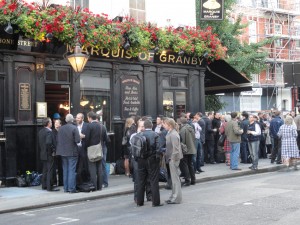
The Marquis of Granby around 18:00 (personal photo)
Even more so than Big Ben, Buckingham Palace, possibly even the Queen herself, the first thing that comes to mind when Americans hear “England” is pubs. (At least when American college students hear “England.”) I don’t think I exaggerate when I say this. (Do I?) When we first arrived in England, hitting the pubs was at the top of our to-do list and it has pretty much stayed there throughout our time here. Whether we are unwinding at the end of the day, or enjoying a (culturally acceptable! awesome) midday pint, it is almost inevitable that we find ourselves in a pub at some point during the day.
In his essay, “The Moon Under Water,” George Orwell describes his ideal pub. Before arriving in England, my romanticized vision of what a pub would be like was much like what Orwell describes. I certainly did not envision strawberry-pink china and children running around as Orwell did, but the familiarity, the “regulars,” and the “atmosphere” were all very distinct in my imagined pub, an amalgamation of bits and pieces, images and texts, from the likes of Harry Potter books and movies, works by Charles Dickens and Shakespeare, paintings, children’s books, and countless other popular culture representations.
While I haven’t experienced exactly what I imagined, not surprisingly, the look of English pubs, what I call the “pub aesthetic,” has been consistent with what I envisioned. Pubs are not light, airy spaces, they are not in line with current commercial interior decorating trends, they are decidedly old-looking. A color palette of some combination of maroon, deep forest green, rich chocolate brown, navy blue, black, and some muted taupe-y hues is de rigueur. Generally, at least some or all of the walls will be wood-paneled, as well as the countertops. The chairs, stools, and tables are generally made of wood as well, possibly with iron bases for extra sturdiness. You will be served your drink in a real glass- nothing is plastic. (An exception to the “pub aesthetic” is the pub popular amongst our group, The Court, which has more of a Potbelly’s/Buffalo Wild Wings atmosphere, and I wouldn’t classify it as a traditional English pub. To me at least, The Court feels a bit artificial, a little too streamlined.)
As American tourists who don’t necessarily know our way around, we often end up in pubs on the main roads in the touristy areas. Also as Americans, we think of drinking as a predominantly nighttime activity, as our bars generally don’t open til 8pm or later. So we were initially puzzled when we discovered that nearly all of the pubs close at 11 and appear deserted after 9pm. We soon discovered that in England, pubs are much more like American coffee shops than American bars.
Like Orwell, I believe the best pubs are those off the beaten path, down the side streets and through the alleys. For the best pub experience, get off of Tottenham Court Rd. and go right at the end of the typical office work hours, then you will find scenes like the one pictured above at the Marquis of Granby. The pubs on the side streets are where you will find the locals, where you will see people drinking on the crowded pavement outside the crowded pub, hear snippets of every day gossip and banter, and observe the Brits really being Brits.
Tags: 2010 Rachel · Uncategorized
September 20th, 2010 · 2 Comments
I have been avoiding the parks post because I initially felt like I had very few interesting things to say about them. I’ve spent a ton of time in Hyde Park (because I keep coming back to see if there will be people at Speakers’ Corner), some time in Regents Park and briefly visited the other ones plus the various greens and squares in the middle of the city. A lot of people have already mentioned that the parks are very beautiful, good places to withdraw from city life, make beauty accessible to people of all classes and economic means, etc. All good points, so I won’t beat them to death with another post about them.
I wandered about Hyde Park to a good two hours one day because I got lost, it’s huge, and the landscaping does a really good job of hiding the existence of a city outside the oasis inside (It’s kind of like how the mega Walmart at Dickinson has no windows so once you get in you lose your ties to the outside world and can’t escape, except Hyde Park is absoloutely beautiful and a not soul sucking). Anyway, what struck me as really weird was that a lot of the park seemed to have no other function than to be pretty. Every park I’ve ever been to at home is composed of a playground to entertain kids and open space to play sports. They might be landscaped or otherwise decorated, but that part takes up very little space. Landscaping at home serves as decoration for a space designed for some other purpose, while her prettiness seems to be the main purpose and other functions (open fields, playgrounds, etc.) are an afterthought in a different section. (I’ve also spent very little time in big city park, so it might just be a difference in suburban and urban parks). For example, the first section in Regents Park does not allow balls, so I had to go to a different, less decorative part to play Frisbee. It’s very deliberately divided up.
Assuming it’s not just an urban suburban difference, I think designing a green space just to be a green space and having these deliberate divisions is very in keeping with the English character, the London character in particular. Kate Fox talks a lot about the obsession with privacy. People like to have their own sectioned off garden with a very high fence. They hold up giant newspapers in the subway, stare straight ahead, or make out in very public places as a way to section themselves off into artificial private spheres. The character, Wemmick, from Great Expectations divides his home and work spheres so completely that he seems like he has multiple personality disorder. It’s as if it’s an English disease (thought I think not necessarily always a bad thing).
London is a crowded place, and I can totally understand the need to have all these spheres to create a semblance of privacy. In the Arran House alone, I’ve been having private skype conversations that my entire hallway can hear while sitting in view of one of the cameras at the desk; I’ve just been pretending it’s a private sphere. Parks in London just seems like a strong physical manifestation of these psychological divisions – a section specifically for just being pretty, a section for runners, a section for team sports, a section for free speech (Speaker’s Corner). It’s the very opposite of the complaints I so often here in the United States about our over-stimulated, forever multitasking populace. It actually makes me wonder if British television, advertisement, and video games are significantly different from American ones. As far as I know British students start specializing much earlier, too. In contrast, our education system stresses the idea of the well-rounded student, good at every subject in school and doing a million extracurriculars to get into (among other types of schools) a prestigious liberal art college that continues to focus on well roundedness (required courses in other disciplines), even though the job market is specialized. That’s getting a little off topic, though.
Bottom line: parks — super pretty. Divided into single purpose sections. Reiterate the idea of British spheres for the purpose of privacy (although I think there are many other purposes and results of those spheres besides privacy).
Pictures coming as soon as my computer stops being lame.
Tags: 2010 Jesse
September 20th, 2010 · 2 Comments
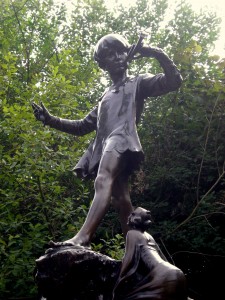
The thing that strikes me most about the parks here in London, aside from the astonishing size and quantity of them, is how kid focused they are. A couple of the girls and I paid a visit to Kensington Gardens last week and discovered this first hand. Before we even entered the park, we could hear the squeals of kids playing on the Diana Memorial Playground. Its design is actually based on the story of Peter Pan. Children can climb aboard Captain Hook’s pirate ship or play in Tiger Lily’s teepee. We wanted to go inside and get some pictures, but the sign on the gate states that if you do not have a child with you, you are not permitted in. I hadn’t ever encountered a child only park, and was honestly a little bit jealous that I couldn’t climb onto the pirate ship.
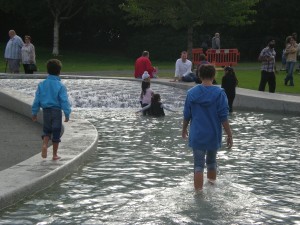
As a New Yorker, I’m partial to Central Park, but even I have to admit that the Brits seem to be beating us in this department. Although Central Park has many things to offer children, it doesn’t have anything that is kids only. I think its really admirable that London’s parks are so devoted to providing kids with a fun and safe environment. The State’s should seriously think about adopting this attitude.
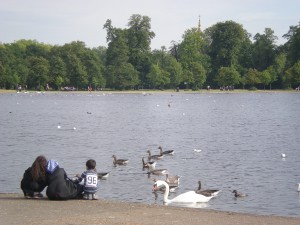
Other locations in the park that seemed geared towards children were the Peter Pan statue, the Round Pond and (spreading into Hyde Park) the Diana, Princess of Wales Memorial Fountain. Although these places were not created specifically for children, it seemed like it was mostly families that were visiting.
Tags: 2010 Sarah
September 20th, 2010 · 3 Comments
When I first got here, I didn’t really understand why Englanders were so big on pubs. All you do is stand around and drink, and then by the time you get tipsy, the last round bell rings and then what? Do you go home? Do you go to another pub? Do you go to a club to party? I guess because of the fact that in the NYC nights out with friends don’t end until about five the next morning, being kicked out of a pub at 11PM to go home and go to sleep felt a little weird and incomplete. It was also strange because I would never eat and drink at the same time. Pub food was surprisingly really tasty to me, especially hot wings and chips.
I agree with George Orwell when he says that the “atmosphere” of a pub is what appeals to people the most. I’ve never been much of a bar type of girl back in the states, but I’ve definitely learned to appreciate and quite enjoy going to pubs once in a while. Generally, a pub that I decide to go to on a particular night varies with my mood and the atmosphere of the club. The three pubs in our area that I most frequently visit are The Marlborough Arms, The Court, and The Rising and they all have three entirely different atmospheres. The Marlborough Arms is fairly quiet compared to the other two, and fosters a mixed crowd in terms of age. In my opinion, the Marlborough has the best tasting pub food and the best service out of all three (their service isn’t even that great, so you can imagine that of the other two). If I am seeking a simple evening out with some friends to have food over a pint or a pitcher of Pimms, then Marlborough is the place for me. I love that fact that it isn’t rowdy and crowded and every time that I’ve walked in I was able to find a table, and kick back and relax without having to scream over other people’s voices and loud music. I actually also really enjoy the completely random music selection at the Marlborough. Rachel, Jamie and Jesse and I really enjoyed having dinner the other night while singing along to “Bootylicious” by Destiny’s Child (click song title for lyrics and then imagine us singing along haha)
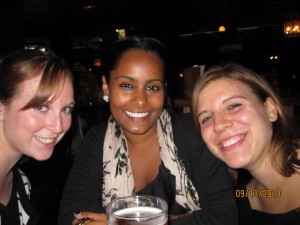
The Court and The Rising Sun slightly different. The Court caters to a younger audience but I am always stuck having to push my way through throngs of people just to get a drink. I’ve never had the food there, but from Sarah’s love of their Cheddar and Bacon fries I guess it’s pretty good. The Court has an upstairs component, which can make a night out with some friends a bit more personal, but you still have to scream over the extremely loud, but entertaining music selection. The Rising Sun also attracts an older audience and is always jammed packed every time I’ve gone there. The service sucks, the food isn’t that great, and the music is okay. So I guess The Rising Sun is my last resort if I’m looking for a pint and nowhere else is open.
Overall, my pub experience has been a good one. I’ve never had any types of altercations with anyone. There was this one time when I asked the waiter for a take away container for some wings that I didn’t finish and when she told me that they didn’t have take away containers I gave her the “what do you mean you don’t have take away containers” look and she probably got offended. Then I realized that it is a pub, not a restaurant, and that people usually finish their food at a pub. Yes, I felt really stupid afterwards, but the waiter smiled and wished me a good night when we were leaving, so I guess it was all good.
Tags: 2010 Melissa
September 20th, 2010 · 5 Comments
I first noticed it one of our first walking tours. We were walking around Bloomsbury when we approached Bedford Square. It was a welcome patch of green and seemed reassuring and welcoming even from our first day in London, but on this day we actually tried to enter the small park. “Well it looks as if the Duke has decided to close the park today,” said Professor Qualls, his voice harboring a tone of disappointment. It was this moment that an idea dawned on me, public spaces in London aren’t truly “public,” they are mercifully given to the people by the aristocracy to brighten up their gloomy lives. For this reason, if the Duke of Bedford would like to have a personal picnic, or the Queen wants a day by the pond, they can close down any park they’d like for their own personal enjoyment.
This fact makes me a little perturbed. What is public space? That is one of the appealing things of Central Park in NYC, it is run by the publicly elected parks department officials. In that way the people decide who runs their parks. This is not the case in London.
The ownership of the “public” space is just another example of the feudal concepts of land ownership that still exist in England today. Just like the museums however, it seems to be the price one pays for perfectly manicured sports fields and classical European gardens that are open to the public. I am of course, talking about one of my favorite parks, Regent’s Park which I was able to return to a few times in pursuit of different things.
When it comes to parks in London however, the crown jewel (pun intended) is of course Hyde Park. It would take days of exploring to uncover all of the hidden landmarks and monuments.
So despite what you might think about the illusion of public space in a Monarchical space, these parks a a great place for a stroll on a sunny British day.
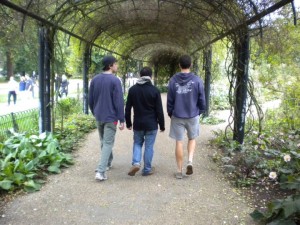
(personal photo)
Tags: 2010 MatthewG
September 20th, 2010 · 1 Comment
On a whim (and because it is the last required museum I haven’t visited), a few of us visited the Sir John Soane museum a couple of Wednesdays ago. Having had no introduction to the museum, we were slightly confused as we arrived at our destination. The man at the gates of this unremarkable-looking English town house first complained that there were eight of us and asked kindly that we “not go around together.” He then had the ladies put their purses into plastic bags to be carried around with them. I had to sign the entire group in on a huge log book and we were off!
We entered the museum but instead of being greeted by an introduction or explanation, we came to room upon room of art and sculpture. The rooms were oddly shaped and almost all lit by giant skylights in the ceilings. As I later learned, John Soane was an architect and he intended his home to serve as an educational space and and inspiration for his students. All of the spaces are top lit so as to allow as much space as possible on the walls for art work. Here’s a picture that gives you an idea of just how packed the museum is. It also shows the high ceilings and circular skylight which was a feature of almost every room.

http://www.creative-freelance.org.uk/reviews/soane.html
I have to say, this was the strangest museum I visited while in London and it was also my favorite. It was unlike any other place we went and it seemed to me quintessentially British. It was inexplicably quirky and reveled in its own strangeness. It was unexpected and unclear and a bit odd.
My impressions of the other museums are as follows:
Victoria and Albert: Interesting but without a cohesive character, unless you count imperialism as a unifying force.
National Portrait Gallery: Anything after 1600 was interesting, anything before was all the same. Admittedly not the most nuanced view but without a bit more context for the portraits I was viewing in the Tudor and Stuart Halls, I was bored by them. I especially enjoyed the Victorian era stuff.
British Museum: Also a product of imperialism but more educational than the Victoria and Albert because I think that the curative work was more focused on teaching us about the places Britain had stolen from. I thought that the podcasts were especially good since they made an effort to contextualize the pieces.
National Gallery: In general, I really enjoyed the artwork. I was disappointed by the Japanese Bridge that they have. Not Monet’s best effort.
Cabinet War Rooms: I enjoyed the War Rooms more for the place than the museum but since the place is so historically important, I found it interesting.
Natural History Museum: The attraction here was more the building than the exhibits themselves which was striking. There are mosaics all over the walls of animals, plants, and fossils. The best exhibit here was also the most mundane. The giant collection of minerals was my favorite part of the museum. It took up an entire hall and held over a hundred cases of any rock or mineral you’d ever want to see.
Tags: 2010 Daniel · Museums · Uncategorized
September 20th, 2010 · 1 Comment
Kate Fox really raised my expectations for London pubs, and I don’t think I’m alone in saying that. I expected pubs full of inside jokes and obscure ales, the kind of dark, smoky environs I can imagine Sherlock Holmes drinking in (and if Robert Downey, Jr was there, too, I wouldn’t complain).
So, after reading all the other pub posts, especially, it’s pretty clear that’s not what we found. In fact, I don’t think I went to a single pub that had genuine “regulars.” Kate Fox didn’t prepare me for impromptu American pop karaoke. She certainly didn’t tell me to develop a taste for Australian, German, Dutch, and even American beers, because there are more of those than real English ales in every pub we’ve been to. And she didn’t prepare me for waitstaff that often presupposes our touristy ignorance of British customs and acts a little confused when we offer “one for yourself.”

The Marlborough Arms - personal photo
But the thing about Fox is, she didn’t prepare me for almost anything about London. I’m not saying I haven’t had a great experience in British pubs – nights out on the town are some of my best memories. Ditto my experience in London. I’ve had a great time. But I haven’t had an authentically British experience here, just like I haven’t been to any authentically British pubs. Even the ones that feel a little more authentic – like the George or the Marlborough Arms – are just cleverly disguised franchises. Like Andrew pointed out, they all have the same menu – fish ‘n’ chips and sausage and mash, printed on faux-antique paper in calligraphy. They seem designed to give the facade of authentic Englishness, while adhering to a tried-and-true modern pub business model of franchises and imported lagers.
Again, I want to be clear that I’m not complaining about pubs or about London (although I’m glad we’re not spending the whole semester here). But when I reflect on my pub experiences, enjoyable though they have been, I don’t feel that I’ve gotten an authentic British experience, just like my time in London has felt mostly like America with accents. I’m looking forward to getting to Norwich and experiencing some more authenticity – and hopefully the kinds of pubs Kate Fox can help us out with.
Tags: 2010 MaryKate · Pubs
September 20th, 2010 · 2 Comments
People have already expounded on many basic rules of pubs: go to the bar to order, know what you’re ordering before you get there, etc. For this rules section, I am going to talk a bit about the Court in particular, which many of us have frequented. There’s a snooker table upstairs (which is honestly just a pathetic imitation of billiards) that is of particular interest to me, as I love shooting pool in my basement and do so quite frequently. I noticed that people rarely went upstairs and simply took table, despite no one else playing – it would be rude to assume priority, as someone may have been thinking about starting a game and simply hasn’t gotten around to it. Only after a bit of time can one start a game. Then, once you start a game, you better get on with it. No silliness can occur, as others are now anxious to play as well. If you’re not good at snooker, then you can abbreviate your playing time by simply forfeiting the table to the next players (quite embarrassing) or by coming up with a discreet and fun way of knocking the balls in by some other means than the typical cue-to-cue-ball-to-other-ball method. We took quite a bit of time on our game, and were actually asked to speed it up. Fortunately there was no awkward overlap as one of the bouncers came upstairs to announce that everyone had to go downstairs.
I don’t particularly understand this everyone-to-the-first-floor rule. Why cram more people into the already-packed downstairs? The only explanation I can muster is that as the night goes on, people are increasingly drunk, and thus prone to act in exponentially dangerous manners. Another rule at the Court does involve ordering drinks, as they sell pitchers of ale, rather than just pints/half pints. To order 4 pints, rather than a pitcher of ale, will warrant you a scoff, from the bartenders and from eager-to-order onlookers. I suppose this is simply due to the increased efficiency of ordering pitchers, and by violating this principle you are delaying other drinks being poured. I also noticed that, at the court, public singing is completely fine, in fact, encouraged. For instance: about a week ago it was some patron’s birthday. Though there were about 8 or so others there clearly to celebrate with her, quite a few (as in, about 30 other people) more joined the chorus for her “happy birthday” song. Another example: R. Kelly’s remix ignition came on (once due to an unknown contributor, and once because of me), which is quite a popular song. I would say about half the pub was singing the chorus, with varying volume levels. This phenomenon occurred with most uber-popular songs. I think this public singing was acceptable and prevalent thanks to the younger crowd the Court… courts.
This type of public singing would NEVER occur at my favorite pub thus far, the George on Fleet st. The George is an older pub (has been around since the late 18th century) and attracts an older, and more reserved crowd. Obviously, their ale selection is great and changes from week to week, though my favorite so far has been a stout called Murphy’s. It’s older and darker interior encourages quiet conversation, which isn’t contaminated by any music. It’s also a lot less crowded than the Court. You don’t have to plow your way through to the bar, and then wait five minutes while desperately trying to capture a bartender. The bartenders are thus more relaxed, and though not necessarily friendly, they aren’t unfriendly either. There are fewer distractions at the George as well – no snooker, and only one plasma TV hanging up in a bit of obscure place, rather than the Court that has multiple TVs on every wall. Instead, there are occasional paintings on the wall. I like this, as it reinforces why we ought to go to pubs: to socialize, to interact with others in a great setting. The only thing I don’t like about the George is that I haven’t been to the mysterious second floor. I also seem to remember there being lanterns inside, but that might be unmitigated optimism. I will check when I go back tonight for one last hoorah.
Overall, it’s a great pub, and one that I will miss when we head out to Norwich in a couple of days. In the most central point I agree with Orwell’s interpretation of what makes a good pub – a nice and quiet inside. Oh, and good beer. Unfortunately there is no garden, but the elusive second floor and flowerboxes out front suffice.
 above: the george, in all its glory. personal photo
above: the george, in all its glory. personal photo
Tags: 2010 ChristopherB · Pubs
September 20th, 2010 · No Comments
I think it will be beating a dead horse at this point to talk about the lack of diversity in the National Portrait Gallery, but I guess I have to a little bit, so sorry horsey. Truthfully, the whole politically correct, inclusive way of thinking about representation is a late 20th century idea. Until that time, when the movement towards serious examination of who is telling/included in the historical narrative was underway, the rich white male’s story was the story, and if it was questioned, it wasn’t questioned openly. So, it was no surprise to me to see walls covered in portraits of the aristocracy and the very famous movers and shakers, and to see no portraits of the poor, lower classes, or racial minorities. (It’s important to note that portraits were mainly done by commission, and to sit for a portrait was time consuming. The lower classes wouldn’t have been able to afford or have the leisure time to have their portraits painted.)
I was, however, surprised by the number of portraits of women I saw. Still not as many as men, but much more than I was expecting. One portrait in particular that caught my attention was the self-portrait of Mary Beale.

Mary Beale, by Mary Beale, oil on canvas circa 1665 (Image from the National Portrait Gallery website)
I was immediately drawn to the richness and depth of the color (this is much more apparent in person). The draping of the Beale’s crimson and steely-plum silk dress suggests a solid, strong body beneath. Her expression is self-assured, yet humble, and she appears competent and adept. After admiring the painting for purely aesthetic reasons, I was even more interested when I read the accompanying text.
Beale worked as a professional painter from the mid-1650s, specializing in portraiture. She was the first Englishwoman to become a portrait painter of real distinction. A daughter of a Suffolk clergyman, by age 27 Beale was a very much in-demand portraitist, particularly for the clergy. Beale’s husband Charles, whom she married at age 19, was also a painter, and he acted as a studio assistant to Beale as well as kept records of all of her commissions. In the self-portrait above, a painter’s palette hangs on the wall in the background, referencing her profession, and she holds in her hand a canvas depicting her two sons, Bartholomew (1656-1709) and Charles (1660-1726).
It was so satisfying to see in the National Portrait Gallery a portrait of woman who was valued for something more than royal or aristocratic blood, or being a wife or mistress to someone of royal or aristocratic blood. How incredibly progressive, in the 17th century no less, for a woman to be honored and admired for her work as something other than being a madonna or a whore. To me, Mary Beale resembles quite closely the “ideal” modern woman. She was a wife and mother, but she was also a respected, talented, accomplished career woman, and that is what takes the historical precedence.
Reference:
Schubert, Gudrun. “Beale, Mary.” In The Oxford Companion to Western Art, edited by Hugh Brigstocke. Oxford Art Online, http://www.oxfordartonline.com/subscriber/article/opr/t118/e213 (accessed September 20, 2010).
Tags: 2010 Rachel
September 20th, 2010 · 1 Comment
London is always described as a global city, a city of history, a city of movement. I have never heard it being described as a city of green space. So I was completely thrown off when I saw the number and magnitude of parks in the city. Literally in every community there is a park whether it’s a well off neighborhood or a less developed neighborhood; it has a park.
In Los Angeles, specifically in the area I live in there are hardly any parks or any parks that you really want to go to. Thus, it was a complete shock seeing such a populated city with so many parks that range in a variety of sizes and functions. The biggest that I have seen by far is Hyde Park. Hyde Park is right next to Buckingham Palace, making its size very logical. Its scenery ranges from fountains surrounded by beautifully well kept flower beds to fields and fields of grass and trees. This park is obviously surrounded by a lot of money to keep up its appearance as well as it is kept.

Around the area we are currently dwelling in, Russell Square is on a significantly smaller scale than Hyde Park but it is likewise surrounded by a well off community. The park is always well kept and sometimes sealed off to the public making access only available to those who live in the square. The park is used by children, yoga instructors, and readers in general. Overall there is a stark difference between life within this park and the surrounding fast pace community. It almost seemed that they have brought the suburb to the city.
Not all parks look as amazing as Hyde Park or Russell Square. In the East End, a community that is largely composed of immigrants from Bangladesh also have a community park, called Altab Ali Park. This park was the first I had seen at the time in London that was commemorating someone rather than being named after its location. Altab Ali was a young 25 year old Bangladeshi clothing worker who was murdered by three white teenage boys on his way home. Just learning about the nature of the name of the park gives you a different feeling about the surrounding community. The community in the East End is tightly knit but it is not necessarily based on their income but rather a form of protection to their neighbors. This park unlike the others is visibly un-kept and run down, a complete difference to those I have mentioned before. So even within British society I see that with money comes political power, sad but true.

Tags: 2010 Jamie













